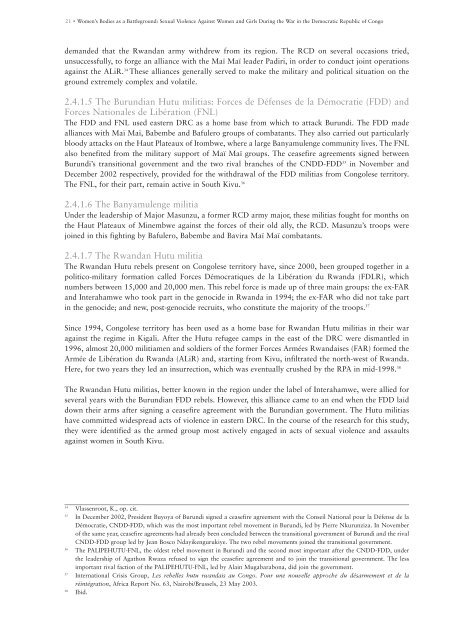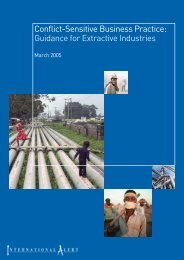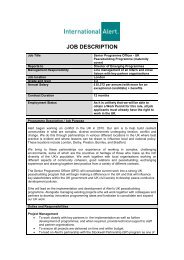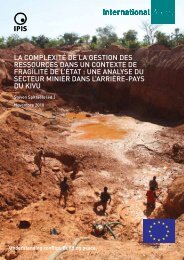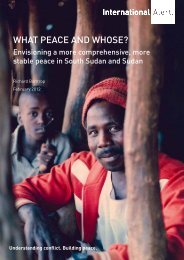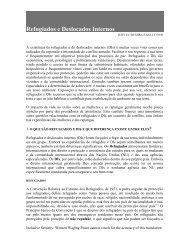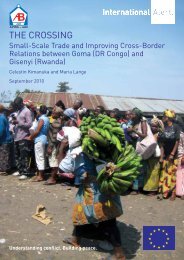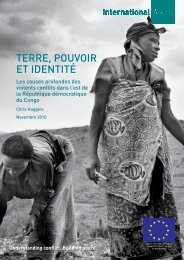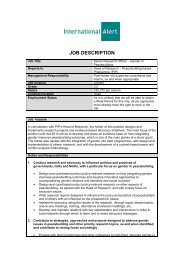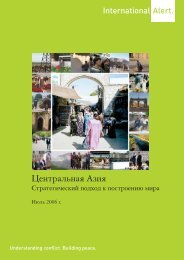Full report - International Alert
Full report - International Alert
Full report - International Alert
- No tags were found...
You also want an ePaper? Increase the reach of your titles
YUMPU automatically turns print PDFs into web optimized ePapers that Google loves.
21 • Women’s Bodies as a Battleground: Sexual Violence Against Women and Girls During the War in the Democratic Republic of Congodemanded that the Rwandan army withdrew from its region. The RCD on several occasions tried,unsuccessfully, to forge an alliance with the Maï Maï leader Padiri, in order to conduct joint operationsagainst the ALiR. 34 These alliances generally served to make the military and political situation on theground extremely complex and volatile.2.4.1.5 The Burundian Hutu militias: Forces de Défenses de la Démocratie (FDD) andForces Nationales de Libération (FNL)The FDD and FNL used eastern DRC as a home base from which to attack Burundi. The FDD madealliances with Maï Maï, Babembe and Bafulero groups of combatants. They also carried out particularlybloody attacks on the Haut Plateaux of Itombwe, where a large Banyamulenge community lives. The FNLalso benefited from the military support of Maï Maï groups. The ceasefire agreements signed betweenBurundi’s transitional government and the two rival branches of the CNDD-FDD 35 in November andDecember 2002 respectively, provided for the withdrawal of the FDD militias from Congolese territory.The FNL, for their part, remain active in South Kivu. 362.4.1.6 The Banyamulenge militiaUnder the leadership of Major Masunzu, a former RCD army major, these militias fought for months onthe Haut Plateaux of Minembwe against the forces of their old ally, the RCD. Masunzu’s troops werejoined in this fighting by Bafulero, Babembe and Bavira Maï Maï combatants.2.4.1.7 The Rwandan Hutu militiaThe Rwandan Hutu rebels present on Congolese territory have, since 2000, been grouped together in apolitico-military formation called Forces Démocratiques de la Libération du Rwanda (FDLR), whichnumbers between 15,000 and 20,000 men. This rebel force is made up of three main groups: the ex-FARand Interahamwe who took part in the genocide in Rwanda in 1994; the ex-FAR who did not take partin the genocide; and new, post-genocide recruits, who constitute the majority of the troops. 37Since 1994, Congolese territory has been used as a home base for Rwandan Hutu militias in their waragainst the regime in Kigali. After the Hutu refugee camps in the east of the DRC were dismantled in1996, almost 20,000 militiamen and soldiers of the former Forces Armées Rwandaises (FAR) formed theArmée de Libération du Rwanda (ALiR) and, starting from Kivu, infiltrated the north-west of Rwanda.Here, for two years they led an insurrection, which was eventually crushed by the RPA in mid-1998. 38The Rwandan Hutu militias, better known in the region under the label of Interahamwe, were allied forseveral years with the Burundian FDD rebels. However, this alliance came to an end when the FDD laiddown their arms after signing a ceasefire agreement with the Burundian government. The Hutu militiashave committed widespread acts of violence in eastern DRC. In the course of the research for this study,they were identified as the armed group most actively engaged in acts of sexual violence and assaultsagainst women in South Kivu.34Vlassenroot, K., op. cit.35In December 2002, President Buyoya of Burundi signed a ceasefire agreement with the Conseil National pour la Défense de laDémocratie, CNDD-FDD, which was the most important rebel movement in Burundi, led by Pierre Nkurunziza. In Novemberof the same year, ceasefire agreements had already been concluded between the transitional government of Burundi and the rivalCNDD-FDD group led by Jean Bosco Ndayikengurukiye. The two rebel movements joined the transitional government.36The PALIPEHUTU-FNL, the oldest rebel movement in Burundi and the second most important after the CNDD-FDD, underthe leadership of Agathon Rwaza refused to sign the ceasefire agreement and to join the transitional government. The lessimportant rival faction of the PALIPEHUTU-FNL, led by Alain Mugabarabona, did join the government.37<strong>International</strong> Crisis Group, Les rebelles hutu rwandais au Congo. Pour une nouvelle approche du désarmement et de laréintégration, Africa Report No. 63, Nairobi/Brussels, 23 May 2003.38Ibid.


